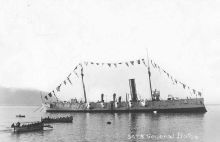Captain Thomas(Tom)Yates Thomson #897 – 1936/37
Born May 10, 1921 at Sydney-on-Vaal, Northern Cape, to Janet (nee Hunter) and Captain William Thomson, formerly of Ayrshire in Scotland, and a member of The Cape Mounted Police. William married Nurse Janet Hunter of Hampstead, North London at the end of the First World War and brought her out to the farm in South Africa where they raised four sons: Dick, Tom, Robin and Chris.
The four Thomson boys grew up in the fresh air of the open veldt with father William’s wise and intuitive gentle guidance and mother Janet’s scrupulous attention to nutrition and hygiene.
Tom had been home schooled on the farm and was so keen on baking that his parents were ready to send him for an apprenticeship with a local pastry chef. But one day his older brother Dick came home from a trip to Cape Town and announced he wanted to finish his schooling at the merchant navy cadet training ship, the SATS General Botha, in Simonstown.
Tom was persuaded to join his brother Dick (GB1936/37 – #896) and they left the arid Northern Cape to join the training ship. He was just 14 years old. Brothers Robin (GB1939/40 – #1067) and Chris (GB1941/42 – #1202) would follow later to also attend the training ship.
In 1937 he graduated from the General Botha and began his 3 year apprenticeship, at the start of 1938 at the age of 16, on the MV “Silver Palmâ€. The ship had a schedule, taking 6 months to travel around the world from her home port of San Francisco. Calling at ports like – Vancouver along the west coast of the USA, through the Panama Canal, up the east coast of the USA calling at Boston and New Orleans, then across the Atlantic to Cape Town. Then up the West coast of Africa calling at all ports as far as Durban then on up the east coast to Mombasa and across the Indian Ocean to Colombo, Madras, Calcutta (here they went into dry dock and the passengers disembarked to tour India). Then on to Penang, Singapore and a number of ports along Sumatra and Java and on to ports in the Philippines. Then they sailed nonstop across the Pacific to Long Beach, Los Angeles before returning to their home port of San Francisco. War broke out two years into his apprenticeship.
Then in December 1940 the ships doctor put him ashore in San Francisco with appendicitis. He spent that Christmas in hospital and his ship, the “Silver Palm” got orders to sail and he was left behind.
So when he was discharged from hospital the company paid for him to take the train across continental USA to meet his ship in New York. This Trans-America journey took 5 days and he described how it was a wonderful opportunity to see America. In New York he was informed that his ship was late. He then signed on as an able seaman to another ship from the company, the MV “Silver Elm†in a convoy to Liverpool.
Traversing the North Atlantic in the middle of winter, four hours on shift and four hours off. Sleeping in his uniform, overcoat and sea-boots – always ready if they were torpedoed.
After arriving safely in the UK he learned that his former ship the “Silver Palm” had been sunk and he had lost all his shipmates. He said that his guardian angel had been watching over him.
Tom’s apprenticeship was up so he now went to study for his Second Mate’s Certificate at the Technicon in Liverpool. He met up with his older brother Dick who was also studying for the Second Mate’s Certificate.
He told many stories from those days, of how he had to study and sit his exams, between air raids at the docks. But it was important that with each qualification he could go back to sea on a higher pay grade.
They both sat the exams and passed. After that Dick went back to the BlueFunnel Line and Tom as 3rd mate to the Silver Line, m.v. ‘Silver Sandal’, which was taken over by Mountbatten’s Combined Operations with a lot of the time being spent sailing between Glasgow and Loch Fyne where they used the ship as a base to practice landing of troops and supplies into barges.
In April 1942 Tom left the Silver Shipping Line when Dick managed to get jobs for both of them on the same ship the SS “Diomed†and they worked their way back to Cape Town, South Africa as supernumeries (3rd and 4th Mates doubling up on the bridge watch).
Tom joined SAR ships operating from SA.
Five years later and just two days before his 24th birthday, when his ship was in Buenos Aires harbor, Germany surrendered. It was May the 8th 1945. He would tell of all the noise and jubilation, and how a solitary bugler started playing the Last Post and every ship horn fell silent as they remembered, amidst all the joy of victory, how many had perished.
Japan surrendered three months later, and the war was finally over.
Tom did his 1st mate and Masters certificates in Durban and served on SAR Ships SS “Ericaâ€, SS “Dalia†and the SS “Agulhas†(aka. “St Jerome†Built 1917) travelling between SA ports, Mauritius, Borneo, the Australian ports from Brisbane to Perth then back to SA via Mauritius to home port of Durban.
A year after the end of the war, by at the age of 25 he made Captain. Promoted to Master of the SA “Agulhas” carrying supplies from South Africa to North Africa and to Borneo in the Far East.
Tom had, had his own “Boys Own Adventure”
He grew up on a farm, at a time, when you learnt to ride as soon as you could walk, because your horse was your transport. He would ride his horse around the diamond digging of Barkly-West accompanied by his faithful Doberman dog.
Then he left the farm to see the world. He circumnavigated the globe and faced peril on the high seas during the war. Navigated the churning “Devil’s Cauldron” on the Congo River in a Tramp steamer and drank beer in the Borneo jungle with an Orangutan sitting on his knee.
In 1950/51, staying with SAR&H, he left the open sea for a harbor post in Walvis Bay as pilot boat/tug master.
He was later transferred to East London. In 1953 while contemplating whether or not to go back to sea he saw his wife to be, Aileen Lewis, at a church service. He truly felt himself at a career crossroads, but would always say he had a guiding angel that day. And so he chose to marry Aileen and to settle in East London.
It was true love and it lasted a lifetime.
He was a hands on father before it was fashionable. Supervising his children’s bath time and reading bedtime stories. He advised on the use of sunscreen and seat belts before anyone else thought of it.
He also loved to point out the stars and name the constellations. He described how it was to see the Northern-lights, the Aurora-borealis, from the bridge of a ship in a North Atlantic convoy.
Tom was a very private man of few words. He always said one of the things he had noted and valued in Aileen was that she was chatty and friendly. And so said that it was a perfect match.
In July 1965, during the “Suez Crisis”, Tom and family were transferred to Cape Town from East London during the “Suez Crisis” when the Cape Town port was busy with shipping diverted around the Cape. He worked long hard hours of shift work, piloting those ships into and out of the harbor.
Tom was a gentle and peaceful man, selfless and undemanding. Never raising his hand or his voice to any person or animal.
When the time came for him to leave us he did that with the same gentleness and peace that he had lived his life.
His children were by his side, holding his hand, the warm morning sun had just begun dancing in through the trees outside his bedroom window onto him as he lay quietly in his bed.
It was Monday 7 July 2014 at thirty-one minutes past nine when his generous and kind and compassionate heart slowed and gently stopped.
He had lots to be proud of. It has been a wonderful life.
He is survived by his children Sandra, Andrew, Peter, John and four grandsons.




